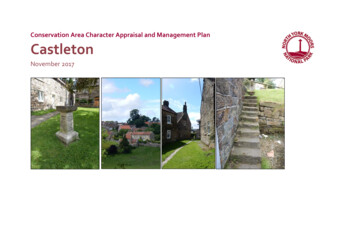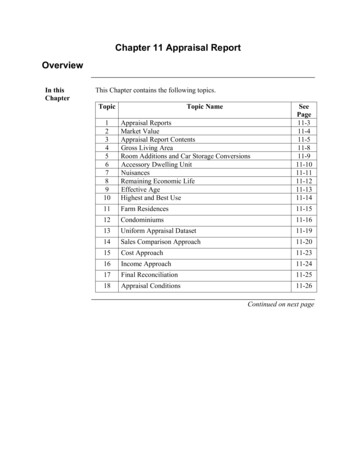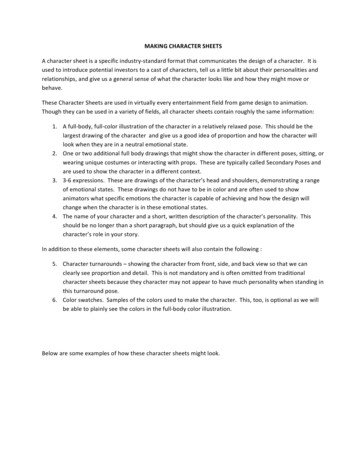
Transcription
Conservation Area Character Appraisal and Management PlanCastletonNovember 2017
2ContentsSummary of Significance3Introduction8Location and context9The History of Castleton11The ancient street plan, surfaces, open spaces and boundaries17The Archaeology24Vistas and views28The historic buildings of Castleton31The little details39Recommendations for future management41Conclusion48Bibliography50Conservation Area Appraisal and Management Plan for Castleton Conservation Area
3Summary of SignificanceCastleton is a village on the River Esk, in the civil parish of Danby in the North York Moors and takes its name from a medieval castle which stood on CastleHill from c.1089. The Conservation Area which includes much of the village, was designated in 1995. The village sits along the end of Castleton Rigg, anoutcrop of Danby High Moor, located towards the head of the Esk Valley and is surrounded with a mixture of pasture and arable. The geology is sandstonewhich has been used to provide local building stone, although brick has also been used from late Victorian times. The ridge top position and the higherground upon which the castle sits, has resulted in undulating ground levels in the village and the need to link some paths with stone steps, and raisedpavements.The presence of a castle would certainly have resulted in additional buildings being constructed around the area, probably where Primrose Hill is today. Thelinear street pattern possibly evolved a little later. A 13th century water-powered corn mill was linked to the village by stone trods and a bridge. Castletonwas the main market and industrial town serving Upper Eskdale with wool, cheese and cattle fairs, and markets throughout the year. Small scale industryincluded iron mining, smelting and quarrying taking place in the surrounding landscape and even some poor-quality coal.Green spaces make an important contribution to the Conservation Area but are limited to the site of the cheese fair on Primrose Hill and the grassy pathsbetween the houses there, the castle earthworks, the grass swards in front of the houses at the east end of the village and down towards the mill onAshfield Road and the site of the former chapel, also at the east end of the village. The open countryside provides an important backdrop to many of theviews from the village; these views can be framed between houses, from the high ground of Primrose Hill and from the sitting area at the east end of thevillage. Much of this countryside has been included in the Conservation Area. Other views which help to appreciate the historic and architectural interest ofthe Conservation Area can be obtained from the north which provides views towards the ridge top and along the main road which helps to appreciate thegently curving nature of the main road. A number of trees already carry Tree Preservation Order status but there are few individual trees within the villagethat add to the interest and are not currently protected in this way and these have been highlighted.Today the Conservation Area consists of mostly street fronted stone cottages and terraces along a winding street. The character of these buildings aremainly domestic houses, with cottagey features rather than polite ones, mostly 18th and 19th century in date, but there are also agricultural buildings, aninn and former chapels. From the middle of the 18th century onwards the old cruck built houses began to be replaced by two storied, modest sized, foursquare, Georgian style houses and it is from this period onwards that the present building character in the village is derived.Although thatch has been used in the past, today the buildings have red pantile (or modern equivalents) or imported Welsh slate as a roofing material.Conservation Area Appraisal and Management Plan for Castleton Conservation Area
4Eighteenth century buildings also use stone water tabling and kneelers on the gables; roofs are adorned with chimney stacks to the ends and in some casesdormer windows and weather vanes.Most door types in the village are traditional cottagey doors, mostly batten and plank with some glazing on modern doors. There are a few Georgian stylesix panel doors and Victorian four panel doors with polished brass or iron furnishings.Traditional window types are to be found throughout the Conservation Area, although there have been some losses where plastic window replacementshave been used. The traditional Yorkshire sash can be found including some leaded glass examples; the multi pane sash is much in evidence as is theVictorian four pane sash.Historic and architectural interest in the Conservation Area is also derived from small features that individually might make little impact, but collectivelycontribute considerably to its character. These include datestones, stone trods, decorated gates and gateposts and door furniture; railings, a mountingblock and milk stand, drinking troughs, horse tie rings, cast iron rainwater goods, weather vanes and wall mounted lanterns.A summary checklist of features of significance in the Conservation Area which should be conserved and enhanced include:Considerable significance The Green on Primrose HillGrassy swards on Station Road, Ashfield Road and between houses on Primrose HillStone retaining wallsStone trods in grass verges (Ashfield Road towards the mill – some possibly still buried)Stone steps between ground levels and raised pavementsStone gatepostsStone flagsCurve to High StreetReused medieval masonry from the castleEarthwork and buried remains associated with the castleNationally important castle remains as earthworks and buried evidenceReused stonework in clapper bridgeEvidence of blocked openings and former buildingsConservation Area Appraisal and Management Plan for Castleton Conservation Area
5 Evidence of changing building form (steeply pitched roofs, heightened buildings)Mill leatsViews between buildings towards the surrounding countrysideViews from the seating area (former chapel site) at the east end of the villageViews of the village from the bridge on Station RoadViews from Station Road northViews from Ashfield Lane towards the countrysideViews from Primrose Hill down Station Road and between the buildingsModest scale of buildings, mostly 0ne to three storeys highStreet fronted or near street fronted propertiesBroken roof lines matching local topographyPredominance of stone building materials, usually good quality ashlar and reused masonryPredominance of red pantile, Welsh slate and chimney stacksStone kneelers and water tablingGeorgian symmetryTraditional timber window styles – Yorkshire sliding sash, lead glazing, multi pane sash and four pane Victorian sash, multi pane bays for exampleTraditional timber doors, panelled or plank and batten, polished brass or iron door furniture.Cast iron rainwater goodsDatestonesAgricultural character (barns, mounting blocks, milk stands)Gable attic window openings to 18th century housesTraditional outbuildingsMounting block and milk standDecorative cast iron rainwater goodsTradition door furnitureDatestonesStone gatepostsDecorative iron gatesConservation Area Appraisal and Management Plan for Castleton Conservation Area
6 Railings to house fronts Stone steps and trods Wall mounted lanterns Some significance Iron railingsGreen sitting area at junction (site of old tin church)Stone setts in parking areasTrees on Primrose Hill green, Ashfield Lane and Church StreetDisused boundary features such as troughsMillstone at the millCold war bunkerViews of the castle motte (site of)Brick buildings and brick and stone combinations (stone to opening surrounds)Traditional shop frontsOverlights to doorsGlazed openings to doors, half glazed mid-20th century timber doorsSundialHorse tie ringsLimited significance Modern weather vane Hanging signs Porches DormersUnknown significance Ha-ha boundary on north edge of Castle HillsConservation Area Appraisal and Management Plan for Castleton Conservation Area
7 Buried archaeology and fabric within buildings from earlier datesGarden archaeology including wells and cess pitsEarly small scale industrial processesSome buildings used for military purposes during the Second World WarThis report has also recommended some modest extensions to the Conservation Area to reconnect the mill complex and the trods leading to the mill withthe rest of the historic settlement within the Conservation Area. Other possible extensions have been considered at the west end of the village so that theschool is included, and views are sought from the local community on these possible extensions.Conservation Area Appraisal and Management Plan for Castleton Conservation Area
8IntroductionMuch of the village of Castleton is a Conservation Area. Conservation Areas were first introduced in England in 1967 in recognition of the fact that thequality of historic areas depends not only on the qualities of individual buildings but also on the historic layout and interrelationship of properties, the useof characteristic building materials, the character of public spaces, the presence of trees and views between buildings and along streets.These places are protected under the provision of section 69 of the Planning (Listed Buildings and Conservation Areas) Act 1990 which defines them asareas ‘of special architectural or historic interest, the character and appearance of which it is desirable to preserve or enhance’.There are over 8000 Conservation Areas in England1 of which 42 are in the North York Moors National Park. Castleton was designated as a ConservationArea in 1995.Historic England recommends that Conservation Areas should be reviewed periodically to assess and communicate why the Area is special and whatcontributes towards its particular qualities. They also recommend that the boundary of the designation should be reviewed and that guidelines areproduced to help with the Area’s long-term management.Conservation Areas give broader protection than the listing of individual buildings, as broader features of historic, architectural and landscape interest arerecognised as part of their character. Conservation Area designation introduces controls over the way owners can alter or develop their buildings. Ownersof residential properties often consider these controls to be beneficial because they also sustain and enhance the attractiveness and value of propertywithin it. These controls include: the requirement in legislation and national and local planning policies for new development to preserve and enhance special character;control over demolition of unlisted buildingscontrol over works to treesfewer types of advertisements which can be displayed without specific permissionrestrictions on the types of development which can be carried out without the need for planning permission (known as “permitteddevelopment rights”)This report assesses those features and qualities which give Castleton its unique special interest and which justify its designation. It seeks to identify -designation/local/conservation-areas/ [accessed 22.12.2016]Conservation Area Appraisal and Management Plan for Castleton Conservation Area
9character-defining elements of the Conservation Area and describes the degrees of significance (considerable, some, limited or none) that can be attachedto those elements such as the street plan, the open spaces, the vistas and views and the historic buildings.It then goes on to make recommendations on how to conserve and enhance those elements of significance and recommendations to guide futuremanagement decisions and development proposals.However, no appraisal can ever be entirely comprehensive and the omission of any particular building, feature or space in the village, should not imply thatit is of no interest.Location and Context“Castleton is a considerable village situated partly on the side of a lofty eminence south of the Esk, and partly in avalley – the parts being called respectively High and Low Castleton. The site of the Castle is on a commandingcircular hill facing the north and east. The hill serves as a sort of buttress to the high ground on which the village isbuilt, abutting upon it about midway.Castleton is the ancient barony, and took its name from the old baronialresidence which stood there. “Castleton Coals” are supplied from this neighbourhood, but they are of a slateyinferior description.” (1857 Whellan’s Trade Directory)Castleton is a village on the River Esk, in the civil parish of Danby in the North York Moors; it was the largest settlement in Eskdale in the 19th century. It islocated 11.5km south-east of Guisborough and takes its name from a medieval castle which was once positioned on Castle Hill and went on to beabandoned when Danby Castle was constructed in the 14th century. The geology is sandstone which has been used to provide local building stone. Thevillage sits along the end of Castleton Rigg, an outcrop of Danby High Moor, located towards the head of the Esk Valley and is surrounded with a mixtureof pasture and arable. In 17 36 the land was divided between meadow, pasture and arable and in the late 18th century much of the common land wasdrained and enclosed by Mr Mewburn of the Howe (the Howe is just outside the Conservation Area) which increased its value and created the field patternwe see today.2 The railway line runs to the north of the village and is outside the Conservation Area.The Conservation Area boundary is drawn very widely on the north side of the village so that it incorporates the castle remains and views towards thecastle. It also includes views to the south west. To the south, the boundary runs down the middle of Ashfield Road and so excludes the stone trods that ledto the mill which is also excluded from the Conservation Area. The boundary is very tight on the south side of the village so that it runs along the 19thcentury extent of the south facing gardens on Church Street which have since been extended.2Ord 1846, 339Conservation Area Appraisal and Management Plan for Castleton Conservation Area
10Figure 1. The current extent ofCastleton Conservation Area Crown copyright 2017. All rightsreserved. Licence number 100042279Conservation Area Appraisal and Management Plan for Castleton Conservation Area
11The History of CastletonThere is no reference to Castleton in the DomesdayBook of 1086, reflecting the fact that the villagetook its name from the local Norman Castle whichwas not built until after c.1089 when Robert de Bruswas given the Forest and Lordship of Danby byWilliam Rufus (William the Conqueror’s son); thecastle was probably built soon after this. The nameCastleton means the enclosure or village (late OldEnglish ‘tun’) by the castle.3 The castle was a mottetype castle, probably originally constructed intimber and replaced with stonework whichstylistically dates to about 1160.4 Adam de Brus lostthe castle to Henry II, before regaining it in 1200. In1271 the castle passed into the Latimer family whenWilliam Latimer acquired it through marriage. TheLatimers owned Castleton for most of thefourteenth century, until the last lord Latimer diedwithout a son in 1381. His estates passed to hisdaughter Elizabeth, wife of John Neville of Raby, andat this point the castle probably began to beneglected in favour of the Neville's own castles.Figure 2. The survey of the castle earthworks conducted for the 1892 OD 25 inch map showing the earthwork remains of the castle including a motte and the remains of a moat to the north.The earthworks clearly spread on to the west side of Station Road which appears to have evolved from the postern gate into the castle.34Ekwall 1987, xiv-xvPevsner 1966, 119Conservation Area Appraisal and Management Plan for Castleton Conservation Area
12Elizabeth was widowed in 1388. From then until 1396 Castleton was in her hands, until her son John inherited on her death. At some point during thisperiod Castleton Castle was abandoned in favour of the newly built Danby Castle, a typical late 14th century rectangular castle. According to local traditionthe castle on Castle Hill was destroyed by fire and the materials used in building the church. Danby Castle and Park are mentioned in 1242 and the castlemay have been the 'capital messuage' of the manor which, together with a small park, was only valued at 6s. 8d. in 1274. It was referred to as a ruined peel(defended tower) in January 1335–6.The presence of a castle would certainly have resulted in additional buildings being constructed around the area. A water-powered corn mill documented in1272 at Howe Mill must have served local farms and a road ran from Castleton to the mill which crossed Danby Beck. This crossing was served by a bridgeprobably from the 13th century and rebuilt c.1807 when the mill was also rebuilt. The herringbone masonry relates to the 19th century rebuild but theundressed stone used for the decking may have been reused from the medieval bridge.5Castleton was the main market and industrial town serving Upper Eskdale. There were annual wool, cheese (both October) and cattle fairs, a cheese marketand a silk mill. Laden waggons lined the street touting their wares in latter days, but earlier accounts suggest that the fair was held on Primrose Hill, thenknown as Stocks Hill because it was where the village stocks were located. This is where a small sun dial now stands to commemorate the cheese fair.However, it is likely that while cheese and other dairy products were sold on Primrose Hill, other goods would have been grouped together and sold indistinctive parts of the High Street. Cheese making diminished after 1946 and the creation of the Milk Marketing Board.6The economic life of the village also relied on industry with iron mining, smelting and quarrying taking place in the surrounding landscape and even somepoor-quality coal.7 For those without jobs or prospects the village had a poor house, located on the margins, just like its inhabitants. This was located inwhat is now known as Ellerstang on Church Street.The parish church was originally located in Danby and so it was to Danby that residents had to travel for worship and ceremonies. In the 18th century, thegrowth of non-Conformism was led here by Wesley who preached in Castleton in 1772 and a Wesleyan chapel went on to be founded in Castleton. The firstwas in a small building to the west of the village between Castleton and High Castleton and is now lost to modern development. A larger building wasconstructed in 1871 on the street front by which time such non conformist religions had greater social acceptability and could afford to be more visible. APrimitive Methodist chapel of (1861) and a Friends' meeting-house for Quakers were also built; a Friends burial ground being located well to the west ofthe village at High Garth by 1853.8 The lack of a church and the drift towards non-conformism, led to an iron church being erected at the joint expense ofViscountess Downe and the Hon. Lydia F. C. Dawnay in 1865; it was not a parish church and so could not be used for burials and weddings, but functioned5Historic England official listing text List entry Number: 1433734Hartley and Ingilby 1975, 427Ord 1846, 78, th/vol2/pp332-340 and OS 1st ed 6 inch6Conservation Area Appraisal and Management Plan for Castleton Conservation Area
13instead as a chapel of ease to Danby. This was located at the junction of Ashfield Road and Church Street and the site is now used as a green space andseating area, although its Victorian railings survive. The green was donated to the village in 1932 by Mr. and Mrs. J.W.R Punch and family according to thecommemorative stone in one of the boundary posts. Castleton was not to have a full parish church until after the First World War when the church of St.Michael and St. George was built in memory of the men who died in the war. The benches, organ screen and panelling at each side of the altar all bear thedistinctive signature of a crouching mouse of Robert Thompson, the ‘Mouseman of Kilburn’.The primary school is located outside the Conservation Area but is a listed building. It was constructed in 1874 along with the adjacent Master’s House andwas known as Danby Board School (hence DBS on the stone gatepost). It was constructed on land given by Lord Downe and the first head master, Mr.William Bull, presided over an initial 65 pupils aged five to eleven, all taught in one room. 9Electric lighting was provided in the village in 1934 and gradually spread to all buildings. The village hosted a Home Guard headquarters during World WarII. The Friends’ Meeting House was used at that time as an HQ to platoons from Castleton (HER 18592), and the cellar of the former Post Office at 7 HighStreet (HER 18096) was used as a Special Duties Branch Out Station. Safely located beyond the village was also an Ammunition Explosives Storage Facilitynorth west of the churchyard (HER 18154). After the War, facilities outside the village were used to monitor the skies and radiation levels by the RoyalObserver Core – the cold war bunker built in 1959 has recently been restored and is occasionally open to the public, but this is outside the ConservationArea.9Wilson 2014, 1Conservation Area Appraisal and Management Plan for Castleton Conservation Area
14Figure 3. the 1st ed OS map 25 inch surveyed in 1892 (blue shading represents the Conservation Area today)Conservation Area Appraisal and Management Plan for Castleton Conservation Area
15Figure 4. 2nd ed OS map surveyed in 1911 (blue shading represents the Conservation Area today)Conservation Area Appraisal and Management Plan for Castleton Conservation Area
16Figure 5. OS 3rd ed 25 inch scale map surveyed in 1927 (blue shading represents the Conservation Area today)Conservation Area Appraisal and Management Plan for Castleton Conservation Area
17The Ancient Street Plan, Surfaces, Open Spaces and BoundariesIn a nutshell: linear ridgeline settlement with remnants of castle layoutThe Street PlanCastleton is a linear settlement which has grown along the ridge between the dales of Eskdale, Westerdale, Commondale and Rosedale and Danby whichmarks the Dale End. It was this strategic position which controlled access along the dales that was certainly a factor in locating the castle here after theNorman Conquest. The castle would have attracted additional settlement beyond its fortified walls and it therefore seems that the oldest building plots arelikely to be closest to the castle along its southern edge in the area now known as Primrose Hill.The buildings on Primrose Hill are clustered in a distinctively different layout to the street fronted houses of the High Street. That, combined with the use ofearlier architectural fragments in the buildings here, suggests that this is the earliest part of Castleton and that the street fronted houses followed. Thiscluster is located at the top of the castle postern, hence the house name, Postgate. The postern is the secondary entry point into and out of the castle and isthe one often used for every day purposes, while ‘gate’ is the traditional Yorkshire term for a road, a term with Norse origins. Station Road may be the laterevolution of the Postgate or Postern and runs through the earthwork remains of the castle which fall on both sides of the road and with the cluster ofbuildings located at the top, suggests that this is the historic core of Castleton. The castle is recorded as being a motte with no bailey, but the presence ofthe buildings at Primrose Hill to a distinctly different layout, but respecting the postern, suggests that the castle may have extended this far south and couldhave functioned as a bailey. There are also sufficient earthworks on the east side to accommodate a bailey.The High Street has a gentle curve to it. This may be to respect the medieval boundary of the castle prior to its demolition and suggests too that the castlecomplex was once much larger. The settlement pattern along the High Street is a standard medieval layout along a main road with linear plots extendingbackwards. On the south side these have been extended southwards in recent times, but the extensions are outside the Conservation Area. Modern housesnorth of the High Street and to the west have not always conformed to this street pattern.Surface Treatments, Open and Green SpacesThere are only a few open green spaces within the village, namely the grassy area on Primrose Hill (where the cheese fair was held) and the grassy swardsthat separate the houses here, the grass frontages to houses on the eastern lower parts of the High Street and the enclosure with seating at the east endof the village (the former chapel site). However, the village is surrounded by grassy fields leading down to the river and the former cornmill and these have been included in the Conservation Area, although the former mill buildings were excluded when the ConservationArea was first laid out.Conservation Area Appraisal and Management Plan for Castleton Conservation Area
18There are wide verges along Ashfield Road dotted with foxgloves, grazing sheep and the occasional mature tree and these swards also have stone trods,albeit a little overgrown. These trods represent an early form of surface treatment linking the village and the mill and characterise early footpaths acrossthe North York Moors. Similarly grazed wide grass verges are to be found along Station Road as it opens out at the bottom of the hill to a large grassy areawith views back to the village and the castle hill. The stone trods disappear before the road reaches the former clapper bridge just before the mill. Thehistoric and architectural interest of this bridge is well camouflaged by the use of modern tarmac on the bridge surface.The only other surface treatments which have historic character are the stone flags outside the inn and on Primrose Hill and stone setts on parking areason the High Street. Otherwise tarmac predominates (especially on the Church Street - Ashfield Road junction), although the narrow strips of tarmac onPrimrose Hill are overgrown by the grassy surrounds which soften its impact and allows the historic character to show through. Primrose Hill also has stonesteps linking its high levels with the street below and these too have considerable historic character.Conservation Area Appraisal and Management Plan for Castleton Conservation Area
19Trees are an important part of the setting and the views to and from the Conservation Area, and a number have already been identified and have TreePreservation Orders. However two additional mature trees stand out within the village at key points and merit protection. One at the foot of Ashfield Roadsits in a grassy verge with broken stone trods at its base. It is currently being used as a tree swing. Another on Church Street between the church andEllerstang sits in a prominent position next to allotments. These allotments were previously three small enclosures presumably used for small scaleproduction by residents since at least the mid-19th century. Slightly younger is a tree planted on the green on Primrose Hill, planted by the Castleton andDanby WI to commemorate the organisation running from 1915 to 1965.The lack of tree management, or inappropriate tree planting also serves to obscure historic interest and can detract from some views. For example, thecastle mound which gives the village its name is almost rendered completely invisible because of tree planting and the church is also obscured from theroad by mature tree planting.Conservation Area Appraisal and Management Plan for Castleton Conservation Area
20 Crown copyright 2017. All rights reserved.Licence number 100042279Figure 6. Existing Tree Preservation Orders (green dots) and red dots mark other significant trees that make a positive contribution to the streetscapeConservation Area Appraisal and Management Plan for Castleton Conservation Area
21BoundariesMost of the houses front on to the road or the grass swards, but some Victorian houses have been designed with dwarf walls topped with railings and somestill survive on the High Street, while some have modern replacement railings and gates. The site of the tin chapel, now a seating area, still retains itsornate Victorian railings, although some are in poor condition. The Old Chapel (now the British Legion) is also set within its own walls, low so that it can beseen from Station Road and High Street. Castle Hills has its own grandiose but sweeping walls and modern gates with pillars topped with urns. Themodern paving on the drive is very urban and contrasts with the stone flags, grass or tarmac seen elsewhere in the village. The concrete fencing aroundPrimrose Hill is a practical safety barrier, inoffensive rather than characterful.Retaining walls along the roads are distinctive, usually of dressed stonework, often topped with vegetation and interrupted by field gates with stonegateposts. There is a mixture of drystone and mortared walls, but generally drystone is used where it is a boundary to a field. Theboundary of Castle Hills to Station Road also appears to have a ha-ha type wall topped with a later yew hedge. Prior to it being plantedit must have protected views from the buildings on top of Castle Hills in the 18th century across the valley to the north, while keepingConservation Area Appraisal and Management Plan for Castleton Conservation Area
22stock out of the gardens. Alternatively, it may have been a pragmatic response to boundary treatment where ground levels were so different between thehigh castle site and the lower fields.Considerable significance Green on Primrose HillGrassy swards on Station Road, Ashfield Road and between houses on Primrose Hi
Castleton is a village on the River Esk, in the civil parish of Danby in the North York Moors and takes its name from a medieval castle which stood on Castle Hill from c.1089. The Conservation Area which includes much of the village, was designated in 1995. The village sits along the end of Castleton Rigg, an










